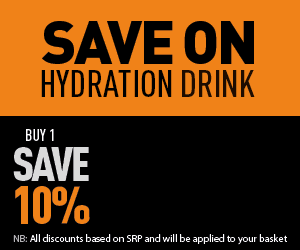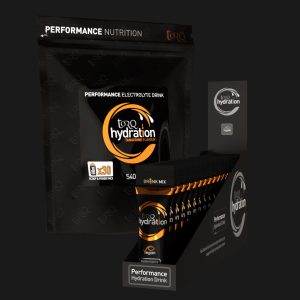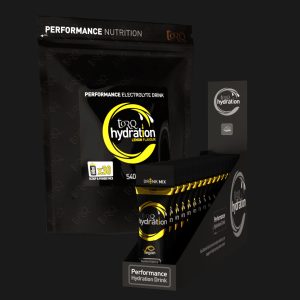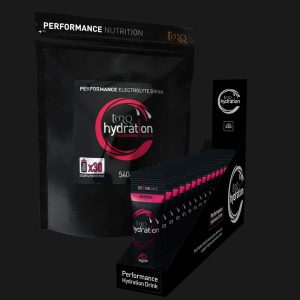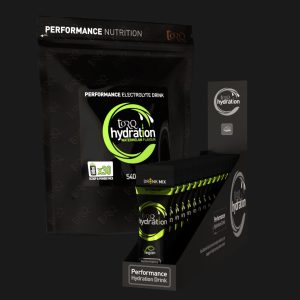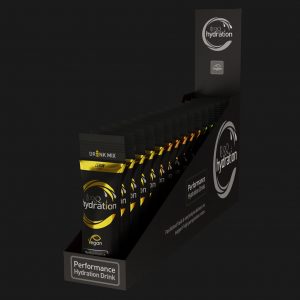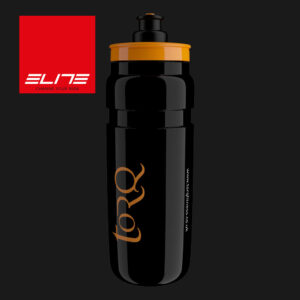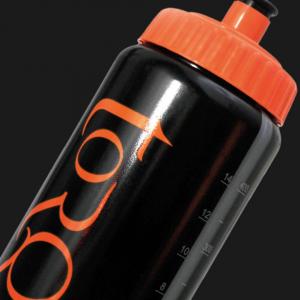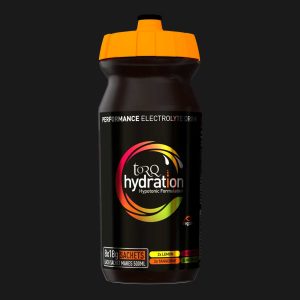Hydration Drink Powder
TORQ Hydration is a mild, lightly flavoured hydrating drink mix. Our Performance Hydration product has been formulated to optimise fluid and electrolyte delivery over and above any other factor.
Showing all 13 results
-
Tangerine Flavour TORQ Hydration
Add to Basket This product has multiple variants. The options may be chosen on the product page -
Lemon Flavour TORQ Hydration
Add to Basket This product has multiple variants. The options may be chosen on the product page -
Red Berries Flavour TORQ Hydration
Add to Basket This product has multiple variants. The options may be chosen on the product page -
Watermelon Flavour TORQ Hydration
Add to Basket This product has multiple variants. The options may be chosen on the product page -
Hydration Drinks: Build-a-Box of 15 sachets
Add to Basket -
TORQ 10 Energy & Hydration Drink Sample Pack
Add to Basket -
TORQ Elite Fly 550 Bottle
Add to Basket This product has multiple variants. The options may be chosen on the product page -
TORQ Elite Fly 750 Bottle
Add to Basket This product has multiple variants. The options may be chosen on the product page -
TORQ Elite Kebea Performance 550ml
Add to Basket This product has multiple variants. The options may be chosen on the product pageNEW! -
TORQ Elite Kebea Performance 750ml
Add to Basket This product has multiple variants. The options may be chosen on the product pageNEW! -
500ml Black Bottle
Add to Basket -
TORQ Hydration 500ml Bottle x 8 sachets
Add to Basket -
Build a Sample Pack
Add to Basket
Product Highlights
- Superior to Electrolyte Tablets
- Fastest Possible Hydration
- Hypotonic Profile with 5 Electrolytes
- Specialist Indoor Training Product
- Perfect for Zwift or Spinning Classes
- Part of the TORQ Fuelling System
Product Summary
TORQ Hydration Drink is available in four light refreshing flavours: Lemon, Tangerine, Watermelon and Red Berries.
TORQ Hydration Drink uses passive and facilitated transport mechanisms to optimise fluid and electrolyte delivery. Its hypotonic formulation capitalises on the passive transport process, whilst the high sodium and mild glucose content drives the facilitated transport activity. This makes TORQ Hydration Drink the most thorough and effective hydration product on the market today, with significant benefits over electrolyte tablets. The short video below explains how the passive and facilitated transport mechanisms work:

TORQ Hydration Drink’s advanced hypotonic formulation is specifically aimed at optimising hydration where events/sessions are no more than an hour long, and heavy sweat loss is anticipated. Indoor training activities like Zwift, Sufferfest and studio cycling for cyclists and other indoor exercise classes like body pump, circuit training and Hyrox are good examples. TORQ Hydration Drink can also be used as part of the TORQ Fuelling System during longer events as an alternative to TORQ Energy Drink and is a popular choice with runners who can combine it with TORQ Gels to satisfy their fuelling and hydration requirements.
If you are not sure whether you should be using TORQ Hydration Drink or TORQ Energy Drink, this article will help you decide: What’s the Difference?
Product Usage
TORQ Hydration is presented either as a 6-sachet multipack (2 sachets of each flavour – each sachet making 500ml), which includes a TORQ Drinks Bottle, as a pouch of 10 single-flavour sachets, or as a pouch containing 540g of Hydration powder and a scoop – enough to make 30 X 500ml drinks. You can also purchase individual flavours to try by building a Sample Pack and as with all orders, we will dispatch it postage-free.
The contents of a sachet or single level scoop of TORQ Hydration Drink powder makes a 500ml of drink. TORQ Hydration Drink mixes very easily, but if using a 500ml bottle, be sure to leave a small amount of air space to facilitate mixing. Shake vigorously and top up with water to make 500ml. Don’t add water to powder, add powder to water. TORQ Hydration is now ready to drink.
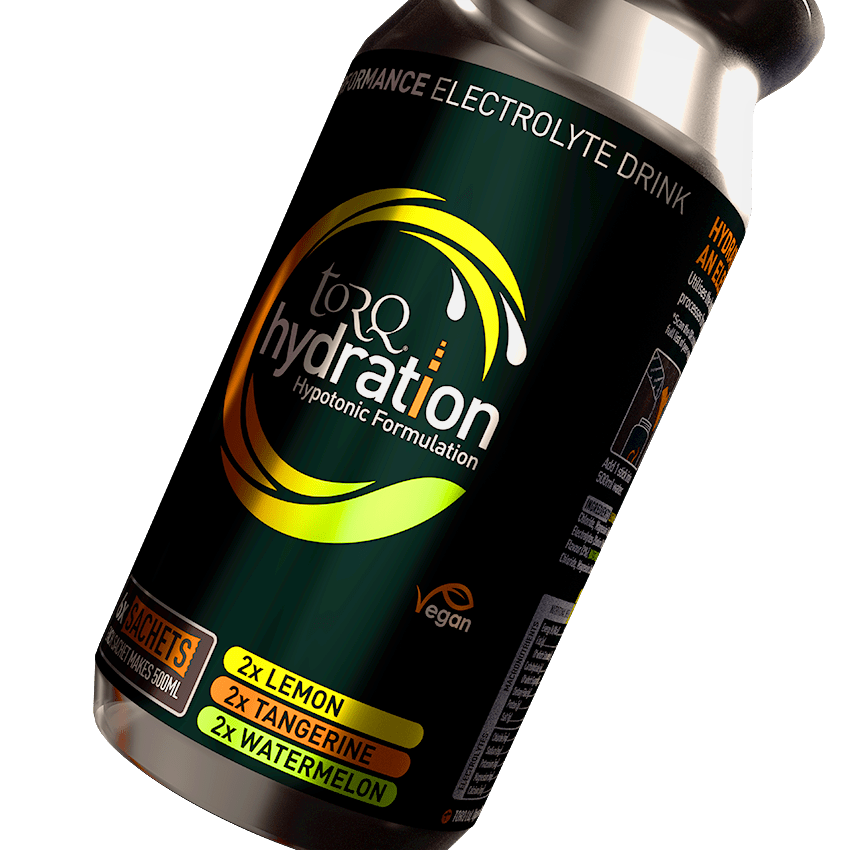
Technical Information
Hypotonicity: For any drink/solution to be effective in hydrating us, it must be rapidly absorbed into the body. One of the main factors affecting how quickly solutions are absorbed, is the speed at which it can move across the wall of the small intestine and into the blood stream. Fluids are absorbed into the body almost exclusively in the small intestine, via two main mechanisms; passive transport, and facilitated transport.
Passive Transport: Here, water moves across the small intestine as a result of an osmotic gradient, which is a result of a pressure difference between the solution in the small intestine and blood stream. Water molecules move across semi permeable membranes (the intestinal wall) through channels called aquaporins. The animation below demonstrates the passive transport process:

Facilitated Transport: Water can also enter the body in the small intestine as a result of the absorption of carbohydrate and sodium, through the process of cotransport. Carbohydrates, such as glucose, are absorbed into the body via a specific transporter called sodium-glucose cotransporter 1, or SGLUT1 for short. These transporters act as a conveyor belt for glucose and sodium, moving them across the small intestine without the need for an osmotic gradient. As carbohydrate and sodium is moved through the SGLUT1 transporter, it also drags with it large volumes of fluid, significantly assisting in hydration. For every single glucose molecule (and 2 sodium molecules) that is moved by SGLUT1, 260 water molecules are moved with it (Loo, Zeuthen, Chandy, & Wright, 1996). The animation below demonstrates the facilitated transport process working in conjunction with passive transport:

The Fastest Possible Method of Hydration: A hypotonic solution offering combined passive and facilitated transport mechanisms represents the fastest possible way to hydrate. In situations where perspiration rates are extremely high over short periods of exercise (up to 60 minutes), including intense indoor turbo/cycling sessions, spinning classes and short competitions in extreme heat, replenishing fluids with TORQ Hydration will deliver superior performance over any other fuelling/hydration strategy.
Electrolytes: TORQ Hydration Drink contains Sodium, Chloride, Magnesium, Potassium and Calcium to replace the 5 electrolytes lost through perspiration. These salts maintain homeostasis within the body, allow it to hold onto water and preserve muscle function. As the animation above demonstrates, the sodium content of TORQ Hydration combined with the light glucose content is essential for the facilitated transport process to take place.
Superior to Electrolyte Tablets: We have been particularly vocal on this website about the misselling of electrolyte tablets for a variety of reasons. Our original article on the subject simply entitled Electrolyte Tablets proved very popular and opened many people’s eyes to the performance and financial disadvantages of using such products. In short, they use artificial sweeteners instead of carbohydrate and therefore can’t take advantage of the facilitated transport process and then of course there’s the controversial issue of artificial sweeteners in general and the unnecessary colours used in these tablets. Since publishing that article we developed our TORQ Hydration Drink on the basis that we wanted to create a product that truly optimised the hydration process and wasn’t compromised in any way. We have since produced follow-up articles entitled Isotonic, Hypotonic or Hypertonic and The Energy Drink Revolution where we further clarify which TORQ products to use and when. In essence the message is, if you need a hydration-only product, use one that works. If you need hydration and fuelling, follow the TORQ Fuelling System and not only will your performance benefit, but you will save money too.
Disadvantages of Pure Water: Pure water is a particularly poor hydrator. Plain water causes bloating due to poor absorption and also suppresses the thirst reflex, leading to decreased desire to drink. It also stimulates urine output and is therefore, inefficiently retained within the body. The carbohydrate and electrolytes in TORQ Hydration’s formulation overcome all of these problems.
Multiple-Transportable Carbohydrates: TORQ Hydration Drink utilises a 2:1 blend of glucose-derivatives and fructose founded on a now substantial body of peer-reviewed published research (see References tab). The carbohydrate sources for TORQ Hydration Drink come from sucrose & dextrose, sucrose being 1:1 glucose-derivatives:fructose and dextrose being 100% glucose-derivatives. This dual-delivery carbohydrate formulation has been proven beyond doubt to supply energy faster than any other combination of carbohydrates or single carbohydrate source formulations. Take a look at the two very short animations below, which demonstrate how 2:1 Glucose-Derivatives:Fructose deliver over 40% more carbohydrate to the blood per hour than single glucose sources (the next best option).


For a comprehensive background to the research into multiple-transportable carbohydrates, visit the TORQ Fuelling System page on this website and look at the tab entitled Why 2:1? Here we thoroughly explain the research and why we have incorporated it into this product and others in the fuelling range.
TORQ Fuelling System Integration: We discuss this in detail on the next tab, but our main complaint about the marketing of electrolyte tablets was and still is that zero carbohydrate means zero fuelling benefit and this isn’t being made clear to customers in our opinion. TORQ Hydration Drink contains 15g of multiple-transportable carbohydrates (60 Kcals) per serve, equivalent to 0.5 TORQ Units. This isn’t nearly enough carbohydrate to fuel longer performances, it is however a lot better than zero carbohydrate. Also, because TORQ Hydration has the same 2:1 glucose-derivatives:fructose ratio as the products in the TORQ Fuelling System range, it can be seamlessly integrated.
Gluten Free & Vegan Formulation: TORQ Hydration Drink is a gluten-free hydration product. The formulation for TORQ Hydration Drink is also entirely plant-based, so is suitable for Vegans.
Natural Flavours and No Colours: Under exercise stress, digestion is affected as blood is diverted to the working muscles and any solutes added to a product will raise its osmolality unnecessarily making it harder to absorb, so irrespective of the health debate surrounding the consumption of artificial ingredients, during exercise is certainly not the time to take them. Therefore, we only use natural flavours that the body can recognise and break down easily and we don’t use colours (artificial or natural), because they simply don’t need to be in the product.
No Artificial Sweeteners: For the same reasons as highlighted above, we don’t believe in the use of artificial sweeteners like Aspatame, Acsulfame-K, Saccharine and Sucralose. These artificial sweeteners are 100’s of times sweeter than sugar and Aspartame/Acsulfame-K are particularly controversial with regard to long-term health. They offer no performance benefit at all and our stance is the same with these as with colours and preservatives – if they don’t need to be included in our formulations for functional reasons, why include them?
TORQ Fuelling System
We accept that some of our customers may prefer the lighter flavours that our TORQ Hydration Drink has to offer over TORQ Energy Drink, yet may also want to use it on longer efforts along with our other fuelling products.
To understand more about the TORQ Fuelling System, please click HERE.
You may want to simplify the TORQ Fuelling System further by effectively keeping fuelling and hydration separate – and this is the key difference/benefit to using TORQ Hydration Drink as part of the TORQ Fuelling System rather than TORQ Energy Drink.
As TORQ Hydration Drink has a very low carbohydrate content, it is literally impossible to over-fuel with it. In order to achieve an intake of 90g of carbohydrate per hour through TORQ Hydration Drink alone, you would need to drink an enormous 3 litres! It would be rare to need to consume more than a litre of fluid per hour in most endurance environments and since we know that a litre of TORQ Hydration Drink will deliver 30g of carbohydrate, a valid approach to fuelling when using TORQ Hydration Drink would be to consume 2 further concentrated TORQ Units per hour (either TORQ Energy Gels, Bars or Jellies). In other words, you could set a reminder on your watch or phone to beep every 30 minutes, at which point you would consume a gel, bar or chew. Your hydration would then be a separate entity and you would simply drink TORQ Hydration to thirst.
Consuming 1 litre of TORQ Hydration along with a concentrated fuelling unit every 30 minutes would provide you with the optimal 90g of carbohydrate per hour (3 TORQ Units).
If you were to drink only 500ml of TORQ Hydration in an hour, with this approach you would take on board 75g of carbohydrate per hour, but this is still a very good level of fuelling. It would still sit within the 2-3 TORQ Units per hour range and would put you somewhere between Intermediate and Advanced on the ‘Easy as 1 2 3’ scale (see TORQ Fuelling System)
In particularly hot conditions, if you were consuming as much as 1.5 litres of fluid per hour, you could simply throttle back your concentrated fuel ingestion to 1 TORQ Unit every 45 minutes. This would give you around 70g of carbohydrate per hour, again putting you into the 2-3 TORQ Units per hour range.
With runners, we recommend adapting the TORQ Fuelling System in this way and using either plain water or TORQ Hydration in combination with a regular intake of TORQ Energy Gels, because this will allow you to take on water at feed stations during events to satisfy your hydration needs, whilst ensuring you take on board the correct amount of fuel. TORQ Hydration is available in sachet form and can be added to a 500ml bottle of water at a feed station if perspiration rates are particularly high and the need for electrolyte intake becomes significant. Runners can use our other concentrated fuelling units (TORQ Bars and TORQ Jellies) along with gels if they wish, it comes down to preference – gels are certainly more popular up to marathon distance.
For cyclists or people taking part in other endurance sports, there’s no reason why you couldn’t adopt this system too – the great thing about the TORQ Fuelling System is that it is hugely adaptive and the products you choose to take on board to fuel and hydrate yourself can come down to preference. Just stick to the key principles and choose the products you prefer to use.
Nutritional Information
Nutritional Information for all flavours of TORQ Hydration Drink are supplied under this tab.
Lemon Flavour
Ingredients: Sucrose, Glucose, Citric Acid, Natural Flavouring (3%), Electrolytes (Sodium, Chloride, Calcium Lactate, Potassium Chloride, Magnesium Carbonate).
| per 100g dry | per 500ml (18g) | |
|---|---|---|
| Energy (kJ) | 1482 | 267 |
| Energy (kcal) | 349 | 63 |
| Fat (g) | 0 | 0 |
| of which saturates (g) | 0 | 0 |
| Carbohydrate (g) | 87 | 16 |
| of which sugars (g) | 62 | 11 |
| Fibre (g) | 0 | 0 |
| Protein (g) | 0 | 0 |
| Salt (g) | 3.8 | 0.68 |
| Chloride (mg) | 2670 | 481 |
| Sodium (mg) | 1526 | 275 |
| Potassium (mg) | 350 | 63 |
| Magnesium (mg) | 32 | 6 |
| Calcium (mg) | 145 | 26 |
Allergen-Free: No gluten containing ingredients used.
No Preservatives // No Colours // No Artificial Sweeteners // Natural Flavouring // Wheat-Free // Dairy-Free // Suitable for Vegans
Tested under ISO 17025 for the presence of prohibited substances.
Red Berries Flavour
Ingredients: Sucrose (57%), Glucose (30%), Electrolytes (Sodium Chloride, Calcium Lactate, Potassium Chloride, Magnesium Carbonate), Acid (Citric Acid), Flavouring (3%).
| per 100g dry | per 500ml (18g) | |
|---|---|---|
| Energy (kJ) | 1510 | 272 |
| Energy (kcal) | 355 | 64 |
| Fat (g) | 0 | 0 |
| of which saturates (g) | 0 | 0 |
| Carbohydrate (g) | 88 | 16 |
| of which sugars (g) | 62 | 11 |
| Fibre (g) | 0 | 0 |
| Protein (g) | 0 | 0 |
| Salt (g) | 3.8 | 0.68 |
| Chloride (mg) | 2672 | 481 |
| Sodium (mg) | 1526 | 275 |
| Potassium (mg) | 350 | 63 |
| Magnesium (mg) | 32 | 6 |
| Calcium (mg) | 145 | 26 |
Allergen-Free: No gluten containing ingredients used.
No Preservatives // No Colours // No Artificial Sweeteners // Natural Flavouring // Wheat-Free // Dairy-Free // Suitable for Vegans
Tested under ISO 17025 for the presence of prohibited substances.
Tangerine Flavour
Ingredients: Sucrose, Glucose, Citric Acid, Natural Flavouring (3%), Electrolytes (Sodium, Chloride, Calcium Lactate, Potassium Chloride, Magnesium Carbonate).
| per 100g dry | per 500ml (18g) | |
|---|---|---|
| Energy (kJ) | 1501 | 270 |
| Energy (kcal) | 363 | 65 |
| Fat (g) | 0 | 0 |
| of which saturates (g) | 0 | 0 |
| Carbohydrate (g) | 88 | 16 |
| of which sugars (g) | 63 | 11 |
| Fibre (g) | 0 | 0 |
| Protein (g) | 0 | 0 |
| Salt (g) | 3.8 | 0.68 |
| Chloride (mg) | 2670 | 481 |
| Sodium (mg) | 1526 | 275 |
| Potassium (mg) | 350 | 63 |
| Magnesium (mg) | 32 | 6 |
| Calcium (mg) | 145 | 26 |
Allergen-Free: No gluten containing ingredients used.
No Preservatives // No Colours // No Artificial Sweeteners // Natural Flavouring // Wheat-Free // Dairy-Free // Suitable for Vegans
Tested under ISO 17025 for the presence of prohibited substances.
Watermelon Flavour
Ingredients: Sucrose, Glucose, Citric Acid, Natural Flavouring (3%), Electrolytes (Sodium, Chloride, Calcium Lactate, Potassium Chloride, Magnesium Carbonate).
| per 100g dry | per 500ml (18g) | |
|---|---|---|
| Energy (kJ) | 1561 | 281 |
| Energy (kcal) | 367 | 66 |
| Fat (g) | 0 | 0 |
| of which saturates (g) | 0 | 0 |
| Carbohydrate (g) | 92 | 17 |
| of which sugars (g) | 65 | 15 |
| Fibre (g) | 0.1 | 0.0 |
| Protein (g) | 0 | 0 |
| Salt (g) | 3.8 | 0.68 |
| Chloride (mg) | 2670 | 481 |
| Sodium (mg) | 1526 | 275 |
| Potassium (mg) | 350 | 63 |
| Magnesium (mg) | 32 | 6 |
| Calcium (mg) | 145 | 26 |
Allergen-Free: No gluten containing ingredients used.
No Preservatives // No Colours // No Artificial Sweeteners // Natural Flavouring // Wheat-Free // Dairy-Free // Suitable for Vegans
Tested under ISO 17025 for the presence of prohibited substances.
Please note: The nutritionals stated per 500ml to 1000ml are mixed at the recommended 3% hypotonic solution. The 100g figure represents the nutritional content of the dry powder before mixing.
pH Data: Watermelon pH 3.8 // Tangerine pH 3.0 // Lemon pH 2.78
If you have any questions about this product or any other on this website, please don’t hesitate in contacting us at enquiries@torqfitness.co.uk or on 0344 332 0852.
Research References
- Baker, L., Jeukendrup, AE. (2014)
Optimal Composition of Fluid-Replacement Beverages. Comprehensive Physiology, 4:575-620. - Meinild, A.K., Klaerke, D., Loo, D.D.F et al (1998)
The human Na+/glucose cotransport is a molecular water pump. Journal Physiology. 508:15-21. - Thomson, A.B., Keelan, M., Thiesen, A., Clandinin, M.T., Ropeleski, M., Wild, G.E. (2001)
Small bowel review: Normal Physiology Part 1. Dig Dis Sci. 46(12):2567-87. - Shi, X., & Passe, D. H. (2010)
Water and solute absorption from carbohydrate-electrolyte solutions in the human proximal small intestine: a review and statistical analysis. Int J Sport Nutr Exerc Metab, 20(5), 427-42. - Loo, D. D., Zeuthen, T., Chandy, G., & Wright, E. M. (1996)
Cotransport of water by the Na+/glucose cotransporter. Proceedings of the National Academy of Sciences, 93(23), 13367-13370. - Stellingwerff, T & Cox, GR. (2014)
Systematic review: Carbohydrate supplementation on exercise performance or capacity of varying durations. Appl Physiol Nutr Metab. 2014 Sep;39(9):998-1011. - Wilson. PB., Ingraham, SJ. (2015)
Glucose-fructose likely improves gastrointestinal comfort and endurance running performance relative to glucose-only. Scand J Med Sci Sports. [Epub ahead of print]. - Currell, K & Jeukendrup, A.E. (2008)
Superior endurance performance with ingestion of multiple transportable carbohydrates. Med Sci Sports Exerc. 40(2):275–81. - Triplett, D., Doyle, D., Rupp, J., Benardot, D. (2010)
An isocaloric glucose-fructose beverage’s effect on simulated 100-km cycling performance compared with a glucose-only beverage. Int J Sport Nutr Exerc Metab. 20(2):122–31 - Tarpey, M.D., Roberts, J.D., Kass, L.S., Tarpey, R.J., Roberts, M.G. (2013)
The ingestion of protein with a maltodextrin and fructose beverage on substrate utilisation and exercise performance. Appl Physiol Nutr Metab. 38(12):1245–53. - Rowlands, D.S., Swift, M., Ros, M., Green, J.G. (2012)
Composite versus single transportable carbohydrate solution enhances race and laboratory cycling performance. Appl Physiol Nutr Metab. 37(3):425–36. - Baur, D.A., Schroer, A.B., Luden, N.D., Womack, C.J., Smyth, S.A., Saunders, M.J. (2014)
Glucose-fructose enhances performance versus isocaloric, but not moderate, glucose. Med Sci Sports Exerc. 46(9):1778–86. - Rowlands, D.S., Thorburn, M.S., Thorp, R.M., Broadbent, S.M., Shi, X. (2008)
Effect of graded fructose co-ingestion with maltodextrin on exogenous 14C-fructose and 13C-glucose oxidation efficiency and high-intensity cycling performance. J Appl Physiol. 104:1709–19. - O’Brien, W.J & Rowlands, D.S. (2011)
Fructose-maltodextrin ratio in a carbohydrate-electrolyte solution differentially affects exogenous carbohydrate oxidation rate, gut comfort, and performance. Am J Physiol Gastrointest Liver Physiol. 300(1):G181–9. - O’Brien, W.J., Stannard, S.R., Clarke, J.A., Rowlands, D.S. (2013)
Fructose–maltodextrin ratio governs exogenous and other CHO oxidation and performance. Med Sci Sports Exerc. 45(9):1814–24. - Rowlands, D.S., Swift, M., Ros, M., Green, J.G. (2012)
Composite versus single transportable carbohydrate solution enhances race and laboratory cycling performance. Applied Physiology, Nutrition, and Metabolism. 37(3): 425-436. - Smith, J.W., Pascoe, D.D., Passe, D., Ruby, B.C., Stewart, L.K., Baker, L.B., et al. (2013)
Curvilinear dose-response relationship of carbohydrate (0–120 g·h−1) and performance. Med Sci Sports Exerc. 45(2):336–41. - Roberts, J.D., Tarpey, M.D., Kass, L.S., Tarpey, R.J., Roberts, M.G. (2014)
Assessing a commercially available sports drink on exogenous carbohydrate oxidation, fluid delivery and sustained exercise performance. J Int Soc Sports Nutr. 11(1):1–14. - Jentjens, R.L., Underwood, K., Achten, J., Currell, K., Mann, C.H., Jeukendrup, A.E. (2006)
Exogenous carbohydrate oxidation rates are elevated after combined ingestion of glucose and fructose during exercise in the heat. J Appl Physiol. 100(3):807–16. - Jeukendrup, A.E & Moseley, L. (2010)
Multiple transportable carbohydrates enhance gastric emptying and fluid delivery. Scand J Med Sci Sports. 20(1):112–21. - Davis, J.M., Burgess, W.A., Slentz, C.A., Bartoli, W.P. (1990)
Fluid availability of sports drinks differing in carbohydrate type and concentration. Am J Clin Nutr. 51(6):1054–7. - Jentjens, R.L., Venables, M.C., Jeukendrup, A.E. (2004)
Oxidation of exogenous glucose, sucrose, and maltose during prolonged cycling exercise. J Appl Physiol. 96(4):1285–91. - Jentjens, R.L., Achten, J., Jeukendrup, A.E. (2004)
High oxidation rates from combined carbohydrates ingested during exercise. Med Sci Sports Exerc. 36(9):1551–8. - Wallis, G.A., Rowlands, D.S., Shaw, C., Jentjens, R.L., Jeukendrup, A.E. (2005)
Oxidation of combined ingestion of maltodextrins and fructose during exercise. Med Sci Sports Exerc. 37(3):426–32. - Jentjens, R.L., Moseley, L., Waring, R.H., Harding, L.K., Jeukendrup, A.E. (2004)
Oxidation of combined ingestion of glucose and fructose during exercise. J Appl Physiol. 96(4):1277–84. - Jentjens, R.L & Jeukendrup, A.E. (2005)
High rates of exogenous carbohydrate oxidation from a mixture of glucose and fructose ingested during prolonged cycling exercise. Brit J Nutr. 93:485–92. - Fuchs, C.J., Gonzalez, J.T., Beelen, M., Cermak, N.M., Smith, F.E., Thelwall, P.E., Taylor, R., Trenell, M.I., Stevenson, E.J., van Loon, L.J. (2016)
Sucrose ingestion after exhaustive exercise accelerates liver, but not muscle glycogen repletion compared with glucose ingestion in trained athletes. J Appl Physi. [Epub ahead of print].
For reviews see…
Jeukendrup, A.E. (2010). Carbohydrate and exercise performance: the role of multiple transportable carbohydrates. Curr Opin Clin Nutr Metab Care. Jul;13(4):452-7.
Rowlands, D.S., Houltham, S., Musa-Veloso, K., Brown, F., Paulionis, L., Bailey, D. (2015). Fructose-Glucose Composite Carbohydrates and Endurance Performance: Critical Review and Future Perspectives. Sports Med. Nov;45(11):1561-76.

